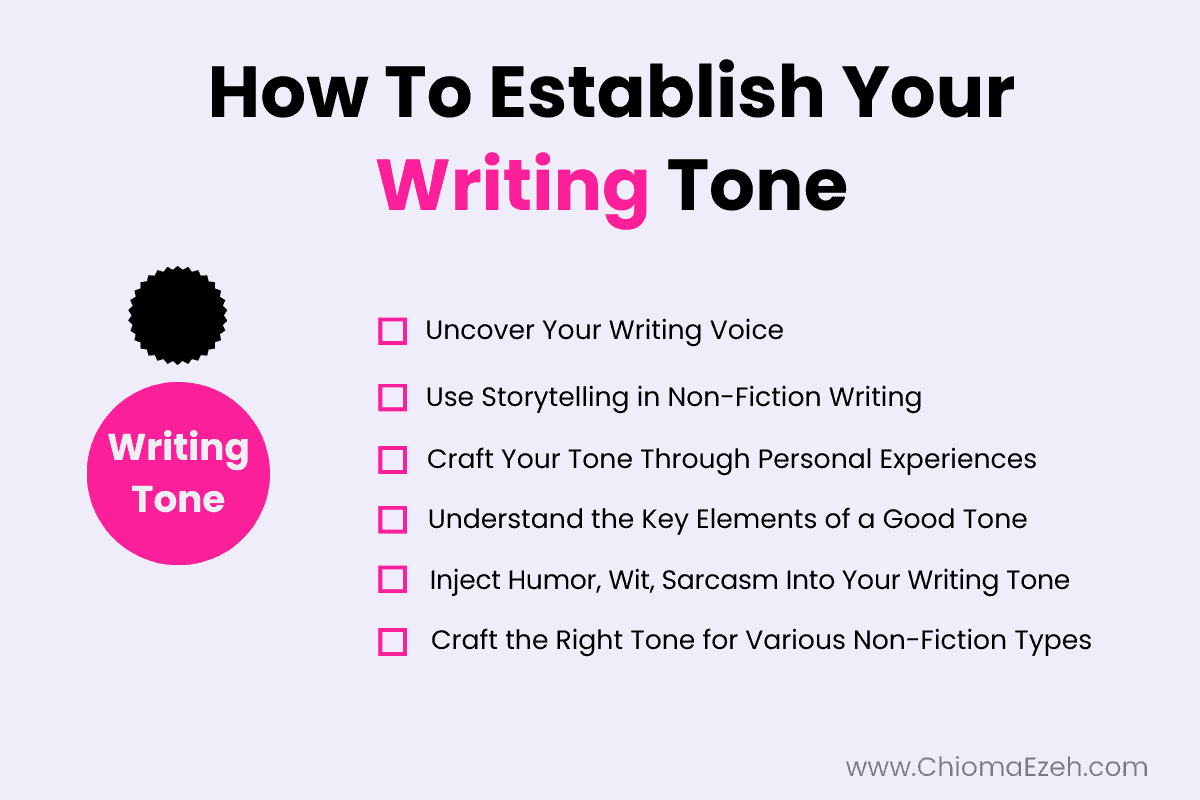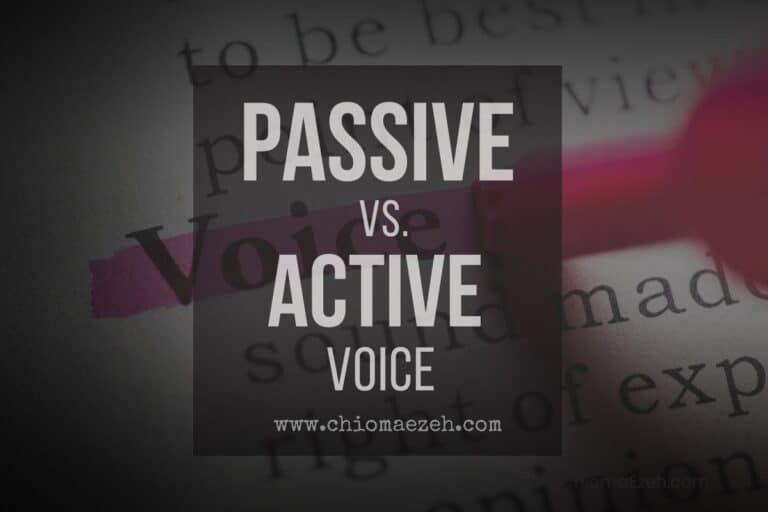Tone In Writing: A Simple Guide For Writers & Authors
Imagine a situation where your friend has just given you a creepy gift that is totally not what you wanted. And then you quickly blurted out:
“Thank goodness, that’s exactly what I was looking for!”
You have simply used sarcasm to lighten the mood and let them know that it isn’t exactly what they were hoping for. The phrase works perfectly in this situation and is the TONE of your message.
Saying this sarcastically signals to the other person that you are not impressed with their gift, but you don’t want to hurt their feelings.

Tone in writing can often be a tricky subject for many writers and authors. As someone who has been writing for over 10 years, I’ve learned firsthand that your writing tone matters just as much as content when it comes to connecting with your audience.
In this article, I’ll go over what a writing tone is, how it differs from voice, and why it’s important, along with some ways to set yourself up for success when crafting yours.
Let’s Talk
Are you a writer aspiring to pen a masterpiece that never fails to captivate? Look no further. Reach out to us and uncover how we can help you to take your writing to unprecedented heights!

What is Tone In Writing?
Tone refers to the writer’s attitude or emotion toward a particular topic. It is an essential element of writing that can be used to convey a message, influence readers, and create a certain atmosphere in writing.
Tone can be formal, casual, serious, humorous, ironic, angry, or any other emotion. Tone can also be used to set a certain mood in writing and create an atmosphere that speaks to the reader.
For example, if you are writing a horror story, you might use an ominous tone that gives the reader a feeling of dread and foreboding. In contrast, in a romantic piece of writing, the tone might be gentle and sentimental to evoke feelings of love and emotion.
Why is writing tone important?
The writer’s attitude is an integral component of any writing, and the tone used can influence how readers interpret the message. It conveys the writer’s attitude and helps readers to understand the message being conveyed. The writing tone can be serious, humorous, formal, informal, angry, or even sarcastic depending on the context and purpose of a particular piece.
Tone can also help set the mood for a story or essay. If you’re composing about a tricky circumstance that has transpired in your life, then maybe an irate tone would be more fitting than using something funny. If you want to elicit laughter, then a jocular approach would be preferable rather than an angry one.
How does Tone fit into our writing?
The choice of words used in writing can also help create different tones. Words such as “enjoyed” rather than “liked” suggest happiness while words like “sorrowful” instead of just “sad” show deeper emotion.
Also, the use of literary devices like metaphors and similes can add additional layers to tone as well; for instance, saying something is “as dark as night” implies much greater darkness than simply saying “dark”.
In addition to using specific language choices, punctuation marks can also have an effect on tone in writing; exclamation points often indicate excitement while ellipses (…) may indicate hesitation or uncertainty about something mentioned previously in the text.
Even capitalization has its place when setting the tone; emphasizing certain words by making them uppercase shows their importance and draws attention from readers who might otherwise miss out on subtle nuances within a piece of writing.
Voice Vs Tone In Writing
It is often difficult to distinguish between tone and voice in writing. Tone refers to the attitude of the writer, while voice pertains to the distinct personality or style that a writer exudes through their words.
Tone is largely defined by diction; how formal or informal language is used can drastically change the overall feeling conveyed by a piece of writing. For example, a casual blog post about travel may have an informal, conversational tone that invites readers to relate to the content, while a research article on the same topic may use more formal diction and be less inviting.
Voice, on the other hand, is closely tied to word choice and sentence structure. It can be consistent throughout a particular piece of writing or it may vary depending on the subject at hand.
At its core, voice is a reflection of the writer’s personality and outlook on life; it can be as unique to the author as a fingerprint. Tone, on the other hand, is more pliable; it can easily be altered depending on the particular situation or audience.
👉 See our guide on tone vs voice in writing
Types of Tone In Writing
Tone is emotion. If you can feel it, there’s a tone to express it! From excitement to joy, anger to sadness, and everything in between, humans use tones to communicate their emotions and share how they feel with others.
Whether we’re talking about the subtle nuances of a whisper or shouted declarations of joy, tones are an important and powerful tool for communicating our feelings. They can be used to express joy, sorrow, love, anger, frustration—even sarcasm.
Even the simplest of words can take on a variety of meanings when expressed with different tones; a simple “hello” could be a warm greeting or an indignant challenge depending on how it’s spoken. There are so many tones in writing but below is a list of the most popular types of tone in writing:
- Formal
- Informal
- Sadness
- Joyful
- Pessimistic
- Optimistic
- Hypocritical
- Fearful
- Angry
- Sincere
- Hopeful
- Serious
- Humorous
- Persuasive
- Sarcastic
👉 To learn more, head over to our article on types of tone in writing
How to Craft Your Writing Tone
Developing a distinct writing tone is essential for any author. Writing in the same voice can help you to create a consistent style that will attract and retain readers. Here are some tips on how to develop your own unique voice:
1) Understand Your Audience: Consider who your target audience is and adjust your writing tone accordingly. Think about the age, gender, and interests of your readers so that you can craft your voice to best suit them.
2) Use storytelling in writing: Storytelling can be an effective technique for reaching your readers and engaging them in your writing. Using thought-provoking stories with a clear beginning, middle, and end will help draw people in and spur them on to read further.
3) Craft an Authentic Tone Through Personal Experiences: Make sure to use experiences from your own life in your writing. This will add authenticity and relatability to your work that readers can relate to.
4) Show Your Passion: People are drawn to authors who have a passion for their subject matter, whether it be through humor, powerful words, or simply a strong enthusiasm for the topic.
By practicing these tips, you should be able to find your own writing tone and style. This can be a great way to stand out as an author and attract readers to your work.
👉 For more tips, please check out the guide on developing your writing style as an author
Examples of Tone in writing
Authors and writers use different tones to communicate effectively.
For example, some may be very formal and serious while others may be more casual and friendly. It all depends on the purpose of the message they are trying to get across.
There are several types of tones in writing but all seem to stem from the same 5 core ones:
- Formal or Academic Tone
- Technical or Informative
- Casual or conversational
- Mixed
- Persuasive
👉 To further breakdown of the different types, see our guide on examples of writing tones
How to Check for Tone In Writing
When checking for tone in writing, you should consider the following elements:
- Word choice – Pay attention to the words that are used throughout the writing. Are they formal or informal? Do they evoke strong emotions or feelings?
- Sentence structure – Is it written with short, simple sentences, or longer, more complex ones? Does it flow well or does it jump from one idea to the next?
- Mood – What is the overall feeling or attitude of the writing? Is it positive, negative, or neutral?
- Voice – Does it sound like the writer’s own voice or is it impersonal and distant? Does it sound direct or indirect?
- Emphasis – Does the writer emphasize certain words or ideas more than others? Are there specific words that stand out and give the tone of the writing an extra boost?
By considering these elements, you can determine the overall tone of any given piece of writing. It is important to remember that tone is subjective and can be interpreted differently by different readers. Therefore, it’s important to be aware of your own biases or interpretations when determining the tone of a piece.
It’s also important to note that the tone may change depending on the context in which it is read.
To accurately assess the tone, you must consider both the writing itself as well as its intended audience. Once you have done this, you can then make an educated guess as to the tone of the writing.
Video Recommendation: Tone In Writing
Final Notes On Writing Tone
The tone of your writing is an essential element to consider when crafting your message.
Depending on the genre and context, you can use different tones to convey emotion or create suspense. When used well, these tonal elements will help ensure that readers understand and engage with your content in meaningful ways.
So take some time to think about which tones might be most effective for what you’re trying to communicate in your writing process.






![How To Write A Story Outline In 6 Steps [Simple Visual Guide]](https://chiomaezeh.com/wp-content/uploads/2023/02/How-to-write-a-story-outline-2-768x512.jpg)